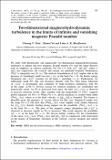Files in this item
Two-dimensional magnetohydrodynamic turbulence in the limits of infinite and vanishing magnetic Prandtl number
Item metadata
| dc.contributor.author | Tran, Chuong Van | |
| dc.contributor.author | Yu, Xinwei | |
| dc.contributor.author | Blackbourn, Luke Austen Kazimierz | |
| dc.date.accessioned | 2013-05-20T16:01:02Z | |
| dc.date.available | 2013-05-20T16:01:02Z | |
| dc.date.issued | 2013-06 | |
| dc.identifier | 47133330 | |
| dc.identifier | 3fc6541f-7d0a-47b3-a57e-b474a9bc060b | |
| dc.identifier | 000319511200008 | |
| dc.identifier | 84880199193 | |
| dc.identifier.citation | Tran , C V , Yu , X & Blackbourn , L A K 2013 , ' Two-dimensional magnetohydrodynamic turbulence in the limits of infinite and vanishing magnetic Prandtl number ' , Journal of Fluid Mechanics , vol. 725 , pp. 195-215 . https://doi.org/10.1017/jfm.2013.193 | en |
| dc.identifier.issn | 0022-1120 | |
| dc.identifier.other | ORCID: /0000-0002-1790-8280/work/61133277 | |
| dc.identifier.uri | https://hdl.handle.net/10023/3539 | |
| dc.description | LAKB was supported by an EPSRC post-graduate studentship. | en |
| dc.description.abstract | We study both theoretically and numerically two-dimensional magnetohydrodynamic turbulence at infinite and zero magnetic Prandtl number $Pm$ (and the limits thereof), with an emphasis on solution regularity. For $Pm=0$, both $\norm{\omega}^2$ and $\norm{j}^2$, where $\omega$ and $j$ are, respectively, the vorticity and current, are uniformly bounded. Furthermore, $\norm{\nabla j}^2$ is integrable over $[0,\infty)$. The uniform boundedness of $\norm{\omega}^2$ implies that in the presence of vanishingly small viscosity $\nu$ (i.e. in the limit $Pm\to0$), the kinetic energy dissipation rate $\nu\norm{\omega}^2$ vanishes for all times $t$, including $t=\infty$. Furthermore, for sufficiently small $Pm$, this rate decreases linearly with $Pm$. This linear behaviour of $\nu\norm{\omega}^2$ is investigated and confirmed by high-resolution simulations with $Pm$ in the range $[1/64,1]$. Several criteria for solution regularity are established and numerically tested. As $Pm$ is decreased from unity, the ratio $\norm{\omega}_\infty/\norm{\omega}$ is observed to increase relatively slowly. This, together with the integrability of $\norm{\nabla j}^2$, suggests global regularity for $Pm=0$. When $Pm=\infty$, global regularity is secured when either $\norm{\nabla\u}_\infty/\norm{\omega}$, where $\u$ is the fluid velocity, or $\norm{j}_\infty/\norm{j}$ is bounded. The former is plausible given the presence of viscous effects for this case. Numerical results over the range $Pm\in[1,64]$ show that $\norm{\nabla\u}_\infty/\norm{\omega}$ varies slightly (with similar behaviour for $\norm{j}_\infty/\norm{j}$), thereby lending strong support for the possibility $\norm{\nabla\u}_\infty/\norm{\omega}<\infty$ in the limit $Pm\to\infty$. The peak of the magnetic energy dissipation rate $\mu\norm{j}^2$ is observed to decrease rapidly as $Pm$ is increased. This result suggests the possibility $\norm{j}^2<\infty$ in the limit $Pm\to\infty$. We discuss further evidence for the boundedness of the ratios $\norm{\omega}_\infty/\norm{\omega}$, $\norm{\nabla\u}_\infty/\norm{\omega}$ and $\norm{j}_\infty/\norm{j}$ in conjunction with observation on the density of filamentary structures in the vorticity, velocity gradient and current fields. | |
| dc.format.extent | 21 | |
| dc.format.extent | 1207709 | |
| dc.language.iso | eng | |
| dc.relation.ispartof | Journal of Fluid Mechanics | en |
| dc.subject | Magnetohydrodynamic Turbulence | en |
| dc.subject | Solution regularity | en |
| dc.subject | QA Mathematics | en |
| dc.subject.lcc | QA | en |
| dc.title | Two-dimensional magnetohydrodynamic turbulence in the limits of infinite and vanishing magnetic Prandtl number | en |
| dc.type | Journal article | en |
| dc.contributor.institution | University of St Andrews. Applied Mathematics | en |
| dc.identifier.doi | https://doi.org/10.1017/jfm.2013.193 | |
| dc.description.status | Peer reviewed | en |
This item appears in the following Collection(s)
Items in the St Andrews Research Repository are protected by copyright, with all rights reserved, unless otherwise indicated.

